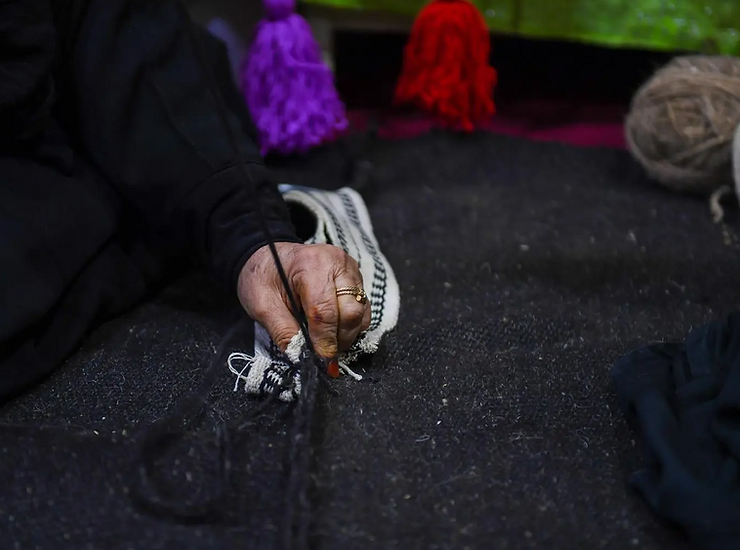
Newsletter Subscribe
Enter your email address below and subscribe to our newsletter

Enter your email address below and subscribe to our newsletter

**Título:** *Northern Borders Weave Cultural Legacy* (6 palabras)
**Intro:**
As winter embraces Saudi Arabia’s Northern Borders, artisans like Umm Nada revive ancient tent-making—a craft blending heritage and community. Women gather to weave goat hair into resilient shelters, merging storytelling with tradition. These tents, symbols of hospitality, now draw tourists seeking authentic connections to the region’s rugged landscapes and enduring cultural roots.
**Factbox (50 palabras):**
– **Location:** Northern Borders, Saudi Arabia
– **Artisans:** Umm Nada & local craftswomen
– **Materials:** Goat/sheep hair, traditional tools
– **Time:** 3–7 days per tent
– **Price:** SAR 1,600–6,000
– **Features:** Weather-resistant, engraved cultural motifs
– **Demand:** Tourism, cultural camping experiences
**Title: Weaving Heritage: The Resurgence of Traditional Tent-Making in Saudi Arabia’s Northern Borders**
**Byline:** November 12, 2024 – Arar, Saudi Arabia
—
**Introduction: A Winter Revival**
As winter’s crisp winds sweep across Saudi Arabia’s Northern Borders, an ancient craft breathes anew. Tent-making, a centuries-old tradition woven into the region’s cultural fabric, is experiencing a vibrant resurgence. More than mere shelters, these handcrafted tents symbolize hospitality, resilience, and a profound connection to the land—a legacy now being revived by artisans like Umm Nada, whose skillful hands bridge the past and present.
—
### **The Artisan: Umm Nada’s Story**
At the heart of this revival is Umm Nada, a master craftswoman whose expertise transforms raw goat and sheep hair into durable, functional tents. “Every thread carries the stories of our ancestors,” she says, her hands deftly working a wooden spindle. For Umm Nada, tent-making is both artistry and homage—a practice honed over decades and passed through generations. Her creations, like those of her peers, are not just utilitarian objects but cultural heirlooms, infused with the spirit of communal life.
—
### **Crafting Heritage: The Tent-Making Process**
The creation of a traditional tent is a meticulous, communal endeavor:
– **Materials & Technique**: Using age-old tools—spindles, looms, and hand-weaving methods—artisans spin and weave goat and sheep hair into thick, weather-resistant fabric. The natural fibers insulate against winter chills and summer heat.
– **Time & Labor**: Each tent takes 3–7 days to complete, depending on size and complexity.
– **A Social Tapestry**: The process is a celebration of community. Women gather to weave, sharing stories, reciting poetry, and singing folk songs. “It’s like stitching our lives together,” Umm Nada remarks.
—
### **More Than Shelter: Cultural Significance**
These tents are a testament to ingenuity and identity:
– **Design & Durability**: Ranging from earthy browns to charcoal grays, the tents blend seamlessly into the rugged landscape. Reinforced with leather and wooden beams, they withstand the region’s harsh winds and sandstorms.
– **Symbolism**: Adorned with intricate engravings, many tents feature motifs depicting tribal histories, desert flora, and celestial patterns. “Every design tells a story,” explains Umm Nada.
– **Pricing & Value**: Priced between SAR 1,600 and SAR 6,000, the tents are investments in heritage, sought after by locals and collectors alike.
—
### **Tents as Bridges to the Past: Tourism and Tradition**
The Northern Borders’ moderate winter climate has made it a magnet for nature enthusiasts and cultural tourists. Visitors flock to experience “authentic Arabia,” sleeping in traditional tents under star-studded skies.
– **Cultural Immersion**: Tourists engage in immersive experiences—sipping cardamom coffee by the fire, listening to oral histories, and learning weaving basics from artisans.
– **Economic Impact**: The demand for tents has bolstered local economies, empowering women artisans and preserving skills at risk of fading.
—
### **A Living Heritage: Preserving Identity in Modern Times**
While modernity reshapes Saudi Arabia, the Northern Borders region exemplifies how tradition and progress coexist. Workshops now blend ancestral techniques with sustainable practices, such as eco-friendly dyes. Meanwhile, social media has amplified interest, with artisans like Umm Nada showcasing their work to global audiences.
“Our tents are more than craft—they’re a heartbeat,” Umm Nada reflects. “As long as we keep weaving, our heritage lives.”
—
**Conclusion: Threads of Continuity**
In the Northern Borders, tent-making is not a relic of the past but a living, evolving tradition. Through the hands of artisans like Umm Nada, each stitch weaves together community, history, and pride. For travelers and locals alike, these tents offer more than shelter—they are portals to a heritage that endures, ensuring the stories of the land and its people resonate for generations to come.
—
**Keywords**: Traditional tent-making, Saudi cultural heritage, Northern Borders tourism, Umm Nada, goat hair tents, Saudi artisan crafts, nomadic traditions.
*Explore the Northern Borders this winter—where every tent is a tapestry of time.*
**15 FAQs About Traditional Tent-Making in Saudi Arabia’s Northern Borders Region**
1. **What materials are used to craft traditional tents in the Northern Borders region?**
Traditional tents are made from goat and sheep hair, woven using age-old techniques. These natural materials provide durability, insulation, and weather resistance, ideal for the region’s harsh climate.
2. **How long does it take to create a single tent?**
A tent can take between three to seven days to complete, depending on its size and complexity. The process involves meticulous hand-weaving and communal collaboration.
3. **Who is Umm Nada, and why is she significant?**
Umm Nada is a skilled artisan renowned for preserving tent-making traditions. Her expertise in transforming raw materials into functional tents has made her a cultural icon in her community.
4. **How do these tents withstand extreme weather conditions?**
The dense weave of goat and sheep hair creates a sturdy, breathable structure that insulates against cold winters and withstands strong winds, making them ideal for the wilderness.
5. **What is the price range for a traditional Northern Borders tent?**
Tents range from SAR 1,600 to SAR 6,000, depending on size, design complexity, and decorative elements like engraved cultural motifs.
6. **Why are these tents sought after by tourists and locals?**
They offer an authentic connection to heritage, durability for outdoor adventures, and a culturally immersive camping experience, blending practicality with historical significance.
7. **How does tent-making preserve the region’s cultural heritage?**
The craft embodies ancestral skills, communal storytelling, and traditional poetry recitals during weaving, ensuring cultural practices are passed to future generations.
8. **What role do women play in tent-making traditions?**
Women lead the craft, gathering to weave tents while sharing stories and poetry. This social ritual strengthens community bonds and preserves oral traditions.
9. **What stories do the tent engravings depict?**
Engravings often feature symbols and narratives tied to the land’s history, tribal identity, and natural landscapes, serving as visual records of the region’s heritage.
10. **How has tourism impacted tent-making in the region?**
Growing tourism has increased demand for traditional tents, providing artisans with economic opportunities while raising awareness about the Northern Borders’ cultural legacy.
11. **Are there variations in tent designs?**
Tents vary in size, color, and decorative details. Some are minimalist and functional, while others feature elaborate patterns for ceremonial or tourist purposes.
12. **How does modernity coexist with tradition in this craft?**
Artisans use timeless techniques while adapting to contemporary needs, such as creating tents for eco-tourism, ensuring relevance without compromising authenticity.
13. **Where can visitors experience these traditional tents?**
Tourists can camp in tents through local guided tours, cultural festivals, or by purchasing them directly from artisans in Northern Borders communities.
14. **Why is the region’s winter climate ideal for tent camping?**
The moderate winters, with crisp air and clear skies, attract nature enthusiasts seeking comfortable conditions to explore the wilderness and stargaze.
15. **How do these tents symbolize hospitality in the Northern Borders?**
Tents represent generosity, serving as communal spaces for hosting guests. Their creation and use reflect the region’s values of unity, heritage, and respect for nature.
**CTA (Llamado a la Acción):**
¿Listo para vivir una experiencia única bajo las estrellas? Visita la región de Northern Borders este invierno y descubre la magia de las tiendas beduinas tejidas a mano. ¡Reserva la tuya ahora o conecta con artesanas como Umm Nada para llevar a casa un pedazo de historia viva! **#CulturaViva #NómadaModerno**
**Conclusión:**
La tradición de las tiendas beduinas en Northern Borders no es solo un legado del pasado, sino un puente entre generaciones que mantiene viva la identidad cultural en un mundo cambiante. Cada hilo tejido por manos expertas cuenta una historia de resiliencia, comunidad y amor por la tierra. Al elegir estas tiendas, los visitantes no solo adquieren un refugio, sino un símbolo de conexión auténtica con una herencia que desafía el tiempo. En un mundo donde lo efímero domina, esta práctica nos recuerda que algunas tradiciones merecen perdurar, no por nostalgia, sino porque encierran el alma de un pueblo.
**Agradecimiento:**
¡Gracias por acompañarnos en este viaje por la tradición y la artesanía de Northern Borders! Valoramos tu interés en descubrir las historias que tejen nuestra cultura. ¿Tienes preguntas, experiencias propias que compartir o deseas saber más sobre cómo apoyar a estas artesanas? ¡Déjanos un comentario o comparte este artículo para que más personas conozcan este tesoro cultural! Tu curiosidad ayuda a mantener viva esta herencia. 🌍✨
**#TradiciónViva #NorthernBorders #TurismoConPropósito**